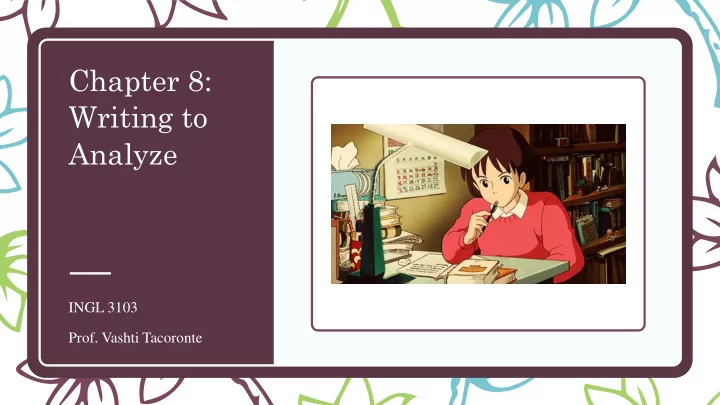

Chapter 8: Writing to Analyze INGL 3103 Prof. Vashti Tacoronte
What is Writing to Analyze? – It starts with a question – You adopt the voice of an Interpreter. – Your purpose is to find patterns, to trace causes and effects, and to determine significance. – Your sources is the source itself. All the information you need is in the text or video you have decided to analyze.
Analytical Documents – Examples of documents which analyze: – Articles – Issue analyses – Rhetorical Analyses – Analytical Blog Post
Articles – Magazine and Newspaper Articles – Relies on information gathered through observations, interviews, correspondence, and personal experience. – They tend to identify their sources in the body of the article.
Issue Analyses – Often begins with a question or a problematic fact. – There is a need to know about and understand the history and significance of their subjects. – It can draw on a variety of sources – Interviews – Surveys – Published Studies – Scholarly Works
Rhetorical Analyses – Takes many forms – Articles, Blogs, Essays, Web pages, Comics – Addresses factors – Writer’s purpose and background – Nature of the audience – Context in which it takes place – Source of the information that reflects the knowledge and interests of their intended reader.
Analytical Blog Post – Allow writers to present their opinions, observations and reflections to a broad readership. – Consists of single writer or they can draw on contributions from multiple writers. – Entries typically are brief and present a personal perspective on an issue. – They are more likely to rely on evidence from other sources than are opinion columns and letters to the editor. – Can use video and audio clips or interactive polls, and link to other sources.
How to write an analytical essay? Find Find a conversation and listen in Ask Ask Interpretive Questions Search Search Databases Conduct Conduct your analysis Prepare Prepare a Draft Review and Review and Improve your draft Improve
Interpretive Questions – A question that is open for discussion lays the foundation for analysis. – To generate interpretive questions, it’s best to: – Brainstorm and Clustering – Freewriting – Prompts – Elements and Categories – History – Causes and Effects – Relationships and Meanings
Conducting your Analysis – A successful essay builds on a carefully crafted analytical question, a thorough understanding of the subject, and a rigorous and fair application of an appropriate interpretive framework. – Refine your question – Will my response interest my readers or address their needs? – Questions leading to factual or Yes/No Answers – When did the Iraq War begin? – Has NASA’s annual budget kept pace with inflation? – Questions Open to Discussion – What caused the Iraq War? – How can NASA pursue its mission on a reduced annual budget?
Apply an Interpretive Framework – Text Analysis – Focus on – Theme, Plot, Setting, Characterization – Contexts – Social, Cultural, Political, Historical – Guidelines – Focus on the text itself – Consider the text in its entirety – Avoid “cherry - picking” – Process of only using materials from a text that support your overall interpretation and ignores aspects that might weaken or contradict your interpretation.
Apply an Interpretive Framework – Rhetorical Analysis – Rhetorical Analysis focuses on one or more aspects of the rhetorical situation. – Writer and Purpose – Readers/Audience – Sources – Context – Guidelines – Remember that the elements of a rhetorical situation are interrelated. – If you analyze the argument in a document, focus on its structure and quality. – Don’t underestimate the complexity of analyzing rhetorical context.
Thank You!
Recommend
More recommend